Author Archive
Document Scanning Services | Converting Records to Digital Imaging
Our Document Scanning Services for Converting Records to Digital Imaging Safely and Efficiently
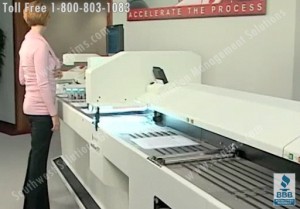 We offer document scanning services to speed up the process of converting records to digital imaging. Using state of the art scanning equipment, we are able to provide document scanning services for converting records to digital imaging securely, affordably and quickly. We work with clients that range from small businesses to very large corporations across all industries, to help migrate your scanned documents across the enterprise to ensure the availability, integrity, and longevity of your records and information. Our document scanning services can stand alone, but we also offer records management consulting to help you create a complete program for document and data management. We will help you plan for the unexpected with our disaster recovery planning services to ensure the integrity of your business. Whether its microfilm, paper, microfiche, or a combination, our clients rely on us to manage and digitize their business critical information.
We offer document scanning services to speed up the process of converting records to digital imaging. Using state of the art scanning equipment, we are able to provide document scanning services for converting records to digital imaging securely, affordably and quickly. We work with clients that range from small businesses to very large corporations across all industries, to help migrate your scanned documents across the enterprise to ensure the availability, integrity, and longevity of your records and information. Our document scanning services can stand alone, but we also offer records management consulting to help you create a complete program for document and data management. We will help you plan for the unexpected with our disaster recovery planning services to ensure the integrity of your business. Whether its microfilm, paper, microfiche, or a combination, our clients rely on us to manage and digitize their business critical information.
Is it Time for Your Business to Move From Paper to Digital Imaging?
Are you wondering if it’s time for your business to move from paper to digital imaging? Studies have shown that workers waste 20 to 40 percent of their time searching for paper documents manually. Ironically, we only spend 5 to 15 percent of our time reading the information. Because 90 percent of our corporate information still resides on paper, having the information where you need it, when you need it is often challenging. Also, when the information is no longer current, we spend even more resources retrieve it, box it, store it, and manage retention schedules. (Read more about digital imaging readiness)
To find out more information on our document scanning services for converting records to digital imaging, just give us a call at 1-800-803-1083 or send us an email. We will put you in touch with one of our records management consultants that will provide you with more details and guide you through the digital imaging process.
Color Coded Folders with RFID Tracking Tags | Efficient File Management
Color Coded Folders with RFID Tracking Tags Helps Financial Services Firm Track Automotive Titles
![]() A national financial services firm recently improved their customer service and created an efficient file management system by using color coded folders with RFID tracking tags. The firm works with dealers all over the nation to finance the purchase of vehicles from over 1,000 inventory sources, manufacturers, and wholesalers. They specialize in individual financing of new and used cars to dealers called floor planning. The financial services firm holds and files the titles as collateral in these loan transactions. The titles are kept in file folders at a centralized records location.
A national financial services firm recently improved their customer service and created an efficient file management system by using color coded folders with RFID tracking tags. The firm works with dealers all over the nation to finance the purchase of vehicles from over 1,000 inventory sources, manufacturers, and wholesalers. They specialize in individual financing of new and used cars to dealers called floor planning. The financial services firm holds and files the titles as collateral in these loan transactions. The titles are kept in file folders at a centralized records location.
There is a large volume of titles constantly being checked in and checked out and managing this process is extremely difficult. The inability to locate title file folders when they are requested results in poor customer service to auto dealers, and inefficient file management operations for the financial services firm.
Pre-numbered Color Coded Folders with RFID Tracking Tags for Quick Access and Efficient File Management
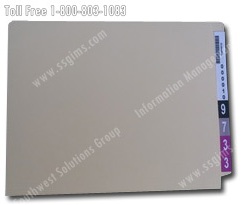 The financial services firm turned to RFID to improve the speed and accuracy of the check-in and checkout process of title file folders. Pre-numbered color coded file folders with RFID tracking tags attached inside the folder were purchased to solve the problem.
The financial services firm turned to RFID to improve the speed and accuracy of the check-in and checkout process of title file folders. Pre-numbered color coded file folders with RFID tracking tags attached inside the folder were purchased to solve the problem.
The color coded file folder labels assist in locating misplaced or misfiled folders, which has improved their efficiencies significantly. At the same time, the RFID tags automate the check-in and checkout file process by keeping track of where all the folders are at any given time and instantaneously updating their location in a database through the use of radio waves and an antenna receiver.
Efficient File Management with Color Coded Folders with RFID Tracking Tags and Filing Solutions Services
Southwest Solutions Group’s Information Management Division provides the experience and knowledge to help you with unique filing solutions for your business. Call us today at 1-800-803-1083 or send us an email to find out how color coded folders with RFID tracking tags will improve your filing process.
Electronic Medical Records (EMR) for Managing Patient Information
 Electronic Medical Records (EMR) for Managing Patient Information
Electronic Medical Records (EMR) for Managing Patient Information
Healthcare providers face many challenges including, protecting patient records, quickly retrieving information, and reducing administrative overhead. Also, the law requires physicians to maintain complete and accurate medical records for each of their patients, and a failure to maintain a record for each patient constitutes professional misconduct.
Investing in an electronic medical records (EMR) system is an excellent way to ensure your healthcare facility will be able to provide efficient, coordinated, cost effective, safe and high-quality patient care.
Benefits of Managing Patient Information with Electronic Medical Records
Electronic Medical Records allow doctors easy access to complete and up to date patient medical records. The EMR provides important information about medications the patients are taking, immunizations, and allergies, which a patient might not remember when they are filling out forms. Also, personnel can quickly update the records with any address changes or insurance changes.
Electronic Medical Records save money. First, they save on the cost of paper and file folders. Second, an EMR system saves space because you no longer have to find areas to store and organize so many paper records. Finally, EMRs save on labor costs because employees can just type a few identifying keystrokes to retrieve a patient’s record instead of sorting through hundreds of file folders to retrieve and re-file a patient charts.
Ready to Convert to an Electronic Medical Records System?
 Whether your business is a hospital, clinic or small private practice Southwest Solutions Group Information Management professionals can help you convert to an Electronic Medical Record System. We offer secure EMR-Compatible HIPAA compliant medical records and patient chart scanning services that are cost effective without sacrificing quality, service, or the privacy of your patients. If you want more information about EMR and our state of the art scanning services, call us at 1-800-803-1083 or send us an email.
Whether your business is a hospital, clinic or small private practice Southwest Solutions Group Information Management professionals can help you convert to an Electronic Medical Record System. We offer secure EMR-Compatible HIPAA compliant medical records and patient chart scanning services that are cost effective without sacrificing quality, service, or the privacy of your patients. If you want more information about EMR and our state of the art scanning services, call us at 1-800-803-1083 or send us an email.
Improving Your Filing Systems By Converting to Color Coded Side Tab Files
Do You Need To Make Changes To Your Filing System?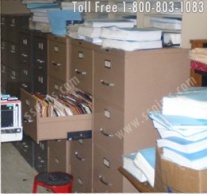
“I hate our filing system. Filing paperwork is so frustrating. Files aren’t in the right place and you have to go searching through offices to try and find files. Our filing cabinets are crammed full of documents and every time we get a new client, we have to move files from one cabinet to another cabinet to make room. No one likes our filing system.”
Does this situation sound familiar to you? If it does, then you have come to the right place. Southwest Solutions Group® recently converted a firm to color coded files with barcode file tracking to solve their file management problems.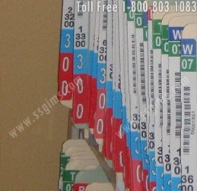
Converting to Color Coded File Folder Labeling Systems
After performing a filing systems needs analysis, we made a recommendation to the firm to convert from top tab legal-size file cabinets to a side tab letter-size color coded shelf filing system. The project included merging several different types of files into one centralized file systems. New file folders were supplied with one-piece color coded labels that included a colored classification label to identify the type of file, as well as the year the file was originated, and the file number. The new color coded system helps personnel find files quicker and helps to identify misplaced files in the system. (click here to read about other consulting services we offer to find what will work best for you)
 Adding Barcode to Improve Tracking File Folders
Adding Barcode to Improve Tracking File Folders
Another part of the redesign of the firm’s filing system was to implement a barcode file tracking system to reduce the time spent searching for files when they were out of the filing system. The barcode file tracking software allows the firm to know exactly where files are located at any given time through a database linking files with employees and locations.
Turning Your File Room Mess into an Efficient Records Management System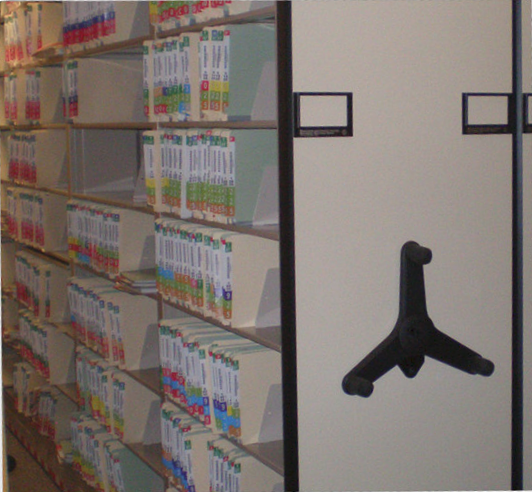
With a new color coded filing system and barcode tracking software, the firm was able to make their employees happy and more productive. If you would like to learn more details about how we were able to help this firm create an efficient records management system, click here to download the PDF file.
I f you would like more information about how Southwest Solutions Group can assist your business with creating an efficient records management system, give us a call at 1-800-803-1083 or click here to send us a message.
f you would like more information about how Southwest Solutions Group can assist your business with creating an efficient records management system, give us a call at 1-800-803-1083 or click here to send us a message.
Improve Your Law Firm’s Records Management with Radio Frequency Identification (RFID) Tracking | RFID File Tags Locate Legal Case Files
Improving Your Law Firm’s File Tracking with RFID
Is records management one of the most problematic areas of your law practice? You know that if your staff can’t find client files when needed, stress, frustration and operational inefficiencies arise in the office. A great solution to this problem is a Radio Frequency Identification (RFID) Records Management System.
How RFID Automatically Tracks and Locates Files with Tags
RFID tracking tags can be embedded in your files or color coded labels to provide an instantaneous location for files or documents. RFID tracking tags come equipped with tiny RFID transmitters built into file labels. The RFID Readers check files in and out of the file room and track the files wherever they go in the office and provide tracking information for when they leave the office. The RFID system enables groups of files to be processed in and out of the file room and automatically updates the file location in the database. This means if a file is moved from one office to another, the RFID software will track the file’s location, which can eliminate search time and frustration in your office. Portable RFID Readers can be used to inventory files circulating in individual offices. All you have to do is wave the Reader around your desk or office and the portable RFID reader will beep when the file is located. (Click here to read a case study on how RFID tracking improved a law firm’s record management)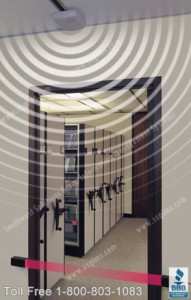
Benefits of Tracking Case Files with the RFID Records Management System
RFID tracking will allow you better management of your case files and other important documents because,
•Locations and statuses of files can be automatically identified and instantaneously updated
•You can track files throughout the workflow whenever they move or change hands
•Finding missing files quickly reduces time wasted searching
 Is Your Law Firm Ready for RFID File Tracking?
Is Your Law Firm Ready for RFID File Tracking?
Southwest Solutions Group’s Information Management Division can help your law firm successfully plan and implement an RFID Records Management Tracking System. Our team of knowledgeable and experienced RFID experts will meet with you to understand your objectives, analyze your current process, and create an innovative RFID solution that meets your specific needs. Call us today at 1-800-803-1083 or email us for more information on how you can find your files when you need them with a RFID Tracking System. We also offer other records management services such as digital imaging for litigation support, managing the lifecycle of records, and RIM audits.
Improving Your Information Management System with DMAIC Planning
Improving Your Information Management System
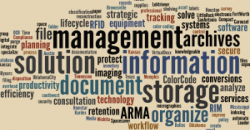 Where do you start when you need to create and/or improve your current records management system? Southwest Solutions Group has a standardized improvement model that provides your team with a consistent road map to develop or upgrade your records management system. The Define, Measure, Analyze, Improve, and Control (DMAIC) model is a structured rigorous approach to process improvement where each phase is logically linked to the previous phase as well as the next phase.
Where do you start when you need to create and/or improve your current records management system? Southwest Solutions Group has a standardized improvement model that provides your team with a consistent road map to develop or upgrade your records management system. The Define, Measure, Analyze, Improve, and Control (DMAIC) model is a structured rigorous approach to process improvement where each phase is logically linked to the previous phase as well as the next phase.
Digital Imaging Systems for Litigation Support
 Digital imaging technology is increasingly important in litigation support. Law Firms that use digital imaging technology realize immediate performance and productivity gains that improve the management of litigation cases, evidentiary documents, discovery files, due diligence records and boilerplate documents. Southwest Solutions Group is a leading provider of secure high resolution scanning, document coding, Bates stamping and full page OCR scans to assist your law firm.
Digital imaging technology is increasingly important in litigation support. Law Firms that use digital imaging technology realize immediate performance and productivity gains that improve the management of litigation cases, evidentiary documents, discovery files, due diligence records and boilerplate documents. Southwest Solutions Group is a leading provider of secure high resolution scanning, document coding, Bates stamping and full page OCR scans to assist your law firm.
Benefits of Converting to Digital Imaging
There are numerous benefits to converting to digital imaging. First and foremost, no more lost or misfiled documents found in paper-based filing systems. Also, many attorneys have heavy travel schedules, yet they still need access to vital documents. Because our digital filing systems provide secure remote access to information, you can quickly retrieve files when and where they are needed on WIFI connected laptops and handheld devices (Blackberry, iPhone, Androids) safely and securely. Some other cost savings and productivity benefits of converting your 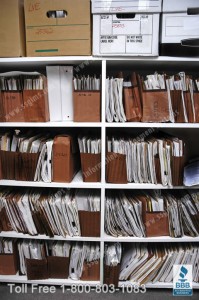 documents to digital imaging are:
documents to digital imaging are:
• Cost savings by reducing the paper file storage requirements will enable your organization to grow, reduce costs, and use floor space for profitable purposes • Cost savings of eliminating off-site storage and document retrieval charges • Increase efficiencies in billable hours and administrative overhead cost savings of making copies and faxing documents • Increase productivity through remote file access using a secure web connection and between offices and departments in different locations (256 Bit SSL Encryption) • Protect your documents from catastrophic loss with a secure disaster recovery plan that provides secure off-site backup and access to information in the event of a disaster • Document workflow, inbound fax receiving, document redaction, editing, and Bates stamping, document consolidation • Integration with your existing Practice Management or Document Management systems • Supplement in house litigation support staff for large cases and remote projects • Unlimited users, document types, and files with no upfront fees • Compatible with most browsers and devices, including iPad, Android, Blackberry, and Mac
Test Our Digital Imaging Services for Free
Our free trial offer includes a full featured document imaging configuration for you to use free for 60 days. There are no restrictions on use within your organization. In addition, we will scan a sample set of files and load them into your viewer to demonstrate the imaging quality of scanned files. We guarantee that our scanned files will be compatible with your practice management and litigation support application.
Why Southwest Solutions Group for Your Digital Imaging System
Southwest Solutions Group is more than a digital imaging conversion company. Southwest Solutions Group has been providing filing products and records management consulting to law firms since 1969. Because we have been helping law firms for years with their paper based filing systems, we understand the flow of critical business documents throughout their lifecycle, from point of creation to final disposition, which offers customers reduced risk and improved operational efficiencies with a verifiable return on investment. We have many qualified information specialists to help you understand the process and protect you from common pitfalls when converting from paper based filing to a document imaging system.
Additional Services by Southwest Solutions Group
We offer many information management services including: • Master planning for converting to document imaging • Document Blowbacks (printing), Bates Stamping. Conversion of digital files (images, worksheets, emails) • Output of load files afro Concordance and other Litigation Support Applications • Backfile scanning of inactive and active records • On-site scanning • High quality production scanning • Packing, purging, and shredding services • Document backup services
Contact us today for more information about our digital imaging free trial at (800) 803-1083 or visit http://www.ssgims.com/legal/
Developing and Managing the Lifecycle of Records
 Importance of Records Management
Importance of Records Management
Records management systems are typically developed in one of two ways. First, there’s the approach most companies take. They start with a very basic filing system that serves the purpose of managing a small collection of records. Often, an entry level staff member with no records management background is tasked with creating the filing system in an attempt to reduce the labor costs associated with the project.
These individuals will use a combination of whatever methods and tools they are most familiar with (top tab folders, alphabetical filing, handwritten labels, basic color coding, etc). As the records continue to accumulate, the filing system becomes more unwieldy and error prone. Things get lost or misfiled, records that should have been discarded long ago keep clogging up the system, and finding a file quickly becomes difficult.
The other approach is to carefully design a filing system that accounts for how files and other information will be managed throughout their lifecycle, regardless of how extensive the records become. Fortunately, it’s never too late to switch from an outdated and inefficient filing system to an information management solution that really meets your company’s needs.
Information Compliance Risks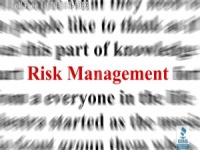
From security to retention, federal and state regulatory agencies have very strict rules for how businesses manage their information and records. Missing documents, incomplete records, or unsecured files are a big liability. Implementing a records management program with properly designed records management software establishes and enforces internal business guidelines that meet government standards. For example, you can set up record retention and disposition schedules to eliminate records that are past their retention date. These practices increase your level of compliance and reduce your risk of government fines and penalties in the event of an audit.
 Advanced Technology Reduces Cost
Advanced Technology Reduces Cost
Various forms of records management technologies will support best practices for managing the lifecycle of records. Technologies like file labeling software, barcode scanning and RFID (Radio Frequency Identification) tagging allows you to track and manage a large number of records quickly and accurately. Paired with the right software solution, you can create a seamless records management system that enhances your ability to create, label, review, inventory, transfer, and dispose of records efficiently. Records management software cuts down on the time you spend looking for (or recreating) missing records. Records management software has advanced security features allowing you to set and restrict access to appropriate personnel. Since a comprehensive audit trail is built in to the technology, you have a complete history showing when each record was create and accessed throughout its lifecycle.
Assessing Your Records and Information Management System
Need help assessing your records and information management system? Southwest Solutions Group provides a free 30 minute phone assessment of your filing system. Call today at 1-800-803-1083 for your free assessment or contact us by email at info@ssgims.com. We have the knowledge, expertise, and products to improve your records management process, no matter what stage it is in!
Click here to see a list of our records management consulting services.
Radio Frequency Identification (RFID) File Technology
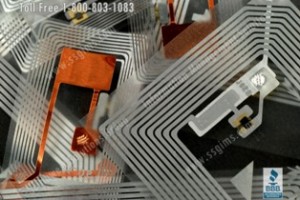 RFID (Radio Frequency Identification) Overview
RFID (Radio Frequency Identification) Overview
Today, barcodes are used for identification in almost all areas of business. Typically about 30% of barcode technology is used in the retail industry. The remaining 70% is used in the government, medical, manufacturing, military, and legal fields. RFID (Radio Frequency Identification) is rapidly increasing in popularity because of its ability to provide accurate and instantaneous information of current and historic locations of items.
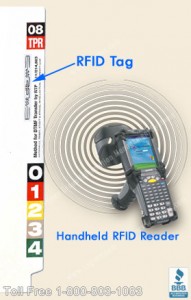 RFID Tracking Advantage
RFID Tracking Advantage
The primary difference between barcode label and RFID tracking technologies is barcode labels require a line of sight for infrared beams to scan a barcode label. RFID utilizes radio frequencies (radio waves) to automatically read small microchips or “tags”. RFID tags have antennas that transmit information to an RFID reader. The RFID reader converts the radio waves into digital data to a computer software interface, providing current and historic tracking information of items as well as their exact locations.
 RFID Proximity Reading
RFID Proximity Reading
Unlike barcode labels that require a line of sight access for scanning, RFID radio tags are read whenever the scanner is within a few feet – even if there are obstructions in the way. This proximity reading capability means you can scan files, boxes, or other items with a handheld or a fixed RFID reader device. These scanning devices automatically log hundreds of tag signals per second from a distance, without the need to physically see the RFID tag. The location data of tagged file folders and other items are instantaneously collated and viewed as a report using a RFID software interface. This means rooms of files or other tracked items can be scanned easily and quickly.
RFID readers are small enough to be installed at many “choke points” throughout your facility for file tracking. Readers can be located on doorways or in individual offices within your organization. When you log in to check the location of a record, you will be able to see where it is located and any stops the record has made along the way.
 Advantages of RFID
Advantages of RFID
Whether you are tracking file folders, record boxes or asset items, RFID technology offers speed and accuracy compared to barcode label tracking. Other benefits to consider are:
- Inventory Control Efficiency: Because line of sight is not required to read RFID tags items can be inventoried no matter where the tag is placed on the file or where the file is within a given area.
- Locating Misplaced Items: Misplaced file locations can be easily pinpointed by using a handheld RFID device. Simply enter in the file number and walk through the file room or office area. The handheld device will increase signals the closer you get to the misplaced file.
- ROI (Return on Investment): although higher in cost initially the cost of ownership will go down if the implementation provides a significant method to improve the business process.
- Damage Vulnerability minimized: RFID tags cannot be damaged like barcodes
Successful RFID Implementation
The key to successful RFID implementation is in understanding and identifying your objectives. Southwest Solutions Group’s Information Management Division provides the experience and knowledge to help you analyze your current processes. Call us today at 1-800-803-1083 to find out how RFID technology can streamline your business processes.
10 Steps to Converting Electronic Medical Records (EMR)
Why Electronic Medical Records (EMR)?
 Healthcare providers all across the U.S. are migrating their medical charts to Electronic Medical Records (EMR) to increase record accuracy, decrease waste, eliminate costly storage space, and improve patient care. Hospitals are also seeking to take advantage of government incentives under the American Recovery and Reinvestment Act (ARRA). Right now, everyone is focusing on the “carrot” of payments they can receive by implementing EMR. But the “stick” comes out in 2015, when hospitals that don’t meet federal guidelines for paperless records may be penalized with reduced Medicare reimbursements.
Healthcare providers all across the U.S. are migrating their medical charts to Electronic Medical Records (EMR) to increase record accuracy, decrease waste, eliminate costly storage space, and improve patient care. Hospitals are also seeking to take advantage of government incentives under the American Recovery and Reinvestment Act (ARRA). Right now, everyone is focusing on the “carrot” of payments they can receive by implementing EMR. But the “stick” comes out in 2015, when hospitals that don’t meet federal guidelines for paperless records may be penalized with reduced Medicare reimbursements.
What’s Holding Healthcare Organizations Back from Using EMR?
 The new government rules to EMR are confusing and picking the right document imaging software system is challenging. Plus, there is significant expense and disruption involved when you make such a big change in how medical records are handled. It’s just not feasible to expect hospitals to do this on their own without expert guidance from information management professionals. Software vendors are happy to sell you imaging hardware and advise you on how to install image software on your computer network; but that doesn’t help with the real-life obstacles you will face in converting your medical file charts to electronic images that can be located when you need them.
The new government rules to EMR are confusing and picking the right document imaging software system is challenging. Plus, there is significant expense and disruption involved when you make such a big change in how medical records are handled. It’s just not feasible to expect hospitals to do this on their own without expert guidance from information management professionals. Software vendors are happy to sell you imaging hardware and advise you on how to install image software on your computer network; but that doesn’t help with the real-life obstacles you will face in converting your medical file charts to electronic images that can be located when you need them.
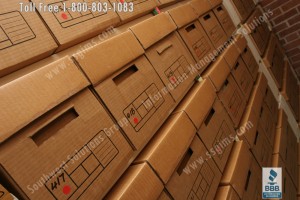 Getting Help Converting Electronic Medical Records
Getting Help Converting Electronic Medical Records
Converting medical records to a document imaging system takes the help of a qualified information management specialist who has experience in the EMR imaging process and government requirements. A qualified information management specialist will help you understand the process and avoid common mistakes that can set your organization back. For example, EMR compatible medical records scanning involves more than simply scanning records and uploading a pdf of a patient’s chart into a database. If you don’t have federally approved quality controls in place, you may end up with a bunch of electronic records that are not considered true originals. That’s an excuse Medicare can use to deny payment. Below is an overview of ten steps to converting your medical documents to Electronic Medical Records.
10 Steps to Converting Your Paper Medical Records to EMR
1. Survey – Review your current filing system to discover the best documents to image 2. Plan – Develop a master plan to map and document every step of the conversion process including establishing your document indexing requirements 3. Pack & Manifest – Box and label medical charts/records to be imaged so they can be tracked throughout the conversion process 4. Secure Transportation – Ship record boxes with documents to be scanned and imaged via a bonded courier directly to a secure image conversion facility 5. Validate Receipt – Have the image conversion facility provide receipt of shipment and confirmation documentation of all documents are present 6. Prep & Scanning – The image conversion contractor should prep documents, removing staples and repairing any damaged records before scanning documents with a high quality production scanners to ensure a high quality, clear and complete scan of each file 7. Indexing – Document The image conversion contractor should index documents according to your specifications established in Step Two 8. Quality Control – Request a sampling of imaged documents to ensure scanning and indexing accuracy of each record 9. Output – Upload the scanned records into your EMR software system or supply on CD/DVD if requested 10. Store or Shred – Provide storage, shredding, or secure shipping instructions for paper records




